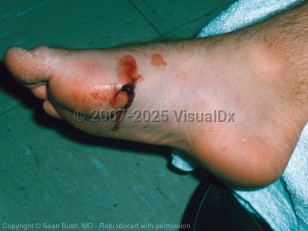Stingray spine puncture
Alerts and Notices
Important News & Links
Synopsis

Stingrays are large, flat fish with whip-like tails that have one or more serrated barbs on the dorsal aspect of their tails. The barbs have 2 ventrolateral venom-containing groves encased in an integumentary sheath. They are bottom dwellers that inhabit the shallow waters in tropical, subtropical, and warm temperate regions, and they often rest in the sand, partially buried with only their spiracles (water intakes), eyes, and tails exposed. There are approximately 150 species worldwide, and a few dozen species are found along US coasts. A few species live in freshwater. Stingrays range in size from a few inches to 4 meters by 2 meters (12 feet by 6 feet).
Stingray venom is predominately cardiotoxic. In low concentrations, the PR interval increases and first-degree atrioventricular (AV) block is seen on the electrocardiogram (ECG). Bradycardia and hypotension may also be present. Higher concentrations produce vasoconstriction, second and third degree AV block, and signs of cardiac ischemia. These cardiac effects typically last only 24 hours. In large doses, stingray venom also appears to be neurotoxic. Seizures and respiratory depression (from inhibition of the medulla) may occur.
Stingrays are nonaggressive but can inflict injury by swinging their tails upward and forward in a reflex action. Two patterns of injury typically result. There can be a slashing type of injury, resulting in laceration wounds, or a puncture type of injury, if the barb is driven into the limb or body of the victim. Venom may be released into the wound when the integument tears and venom escapes. Removal of the retro-serrated barb causes further damage. Barb or integument fragments may be left within the wound.
Thousands of stingray injuries occur each year in the Unites States. Most occur when stingrays are accidentally stepped on or when stingrays get caught in nets or on hooks. Stingray injuries typically induce immediate pain, edema, discoloration, and bleeding. Tissue necrosis, infection, and osteomyelitis may develop. The pain often worsens over the first 1-2 hours, improves within 6-10 hours, and may last for days to weeks. Bleeding may be profuse.
With systemic envenomation, the victim may develop nausea, vomiting, diarrhea, abdominal pain, anorexia, headache, fever, chills, diaphoresis, edema, muscle cramps, tremors, seizures, weakness, paralysis, hypotension, bradycardia, syncope, and respiratory depression.
Death is rare but can occur from either physical trauma, such as penetration of major vessels or body cavities (pleural, pericardial, or peritoneal) or from complications associated with envenomation.
Stingray venom is predominately cardiotoxic. In low concentrations, the PR interval increases and first-degree atrioventricular (AV) block is seen on the electrocardiogram (ECG). Bradycardia and hypotension may also be present. Higher concentrations produce vasoconstriction, second and third degree AV block, and signs of cardiac ischemia. These cardiac effects typically last only 24 hours. In large doses, stingray venom also appears to be neurotoxic. Seizures and respiratory depression (from inhibition of the medulla) may occur.
Stingrays are nonaggressive but can inflict injury by swinging their tails upward and forward in a reflex action. Two patterns of injury typically result. There can be a slashing type of injury, resulting in laceration wounds, or a puncture type of injury, if the barb is driven into the limb or body of the victim. Venom may be released into the wound when the integument tears and venom escapes. Removal of the retro-serrated barb causes further damage. Barb or integument fragments may be left within the wound.
Thousands of stingray injuries occur each year in the Unites States. Most occur when stingrays are accidentally stepped on or when stingrays get caught in nets or on hooks. Stingray injuries typically induce immediate pain, edema, discoloration, and bleeding. Tissue necrosis, infection, and osteomyelitis may develop. The pain often worsens over the first 1-2 hours, improves within 6-10 hours, and may last for days to weeks. Bleeding may be profuse.
With systemic envenomation, the victim may develop nausea, vomiting, diarrhea, abdominal pain, anorexia, headache, fever, chills, diaphoresis, edema, muscle cramps, tremors, seizures, weakness, paralysis, hypotension, bradycardia, syncope, and respiratory depression.
Death is rare but can occur from either physical trauma, such as penetration of major vessels or body cavities (pleural, pericardial, or peritoneal) or from complications associated with envenomation.
Codes
ICD10CM:
T63.511A – Toxic effect of contact with stingray, accidental, initial encounter
SNOMEDCT:
241826002 – Poisoning by sting ray
T63.511A – Toxic effect of contact with stingray, accidental, initial encounter
SNOMEDCT:
241826002 – Poisoning by sting ray
Look For
Subscription Required
Diagnostic Pearls
Subscription Required
Differential Diagnosis & Pitfalls

To perform a comparison, select diagnoses from the classic differential
Subscription Required
Best Tests
Subscription Required
Management Pearls
Subscription Required
Therapy
Subscription Required
References
Subscription Required
Last Updated:10/19/2017
Stingray spine puncture

